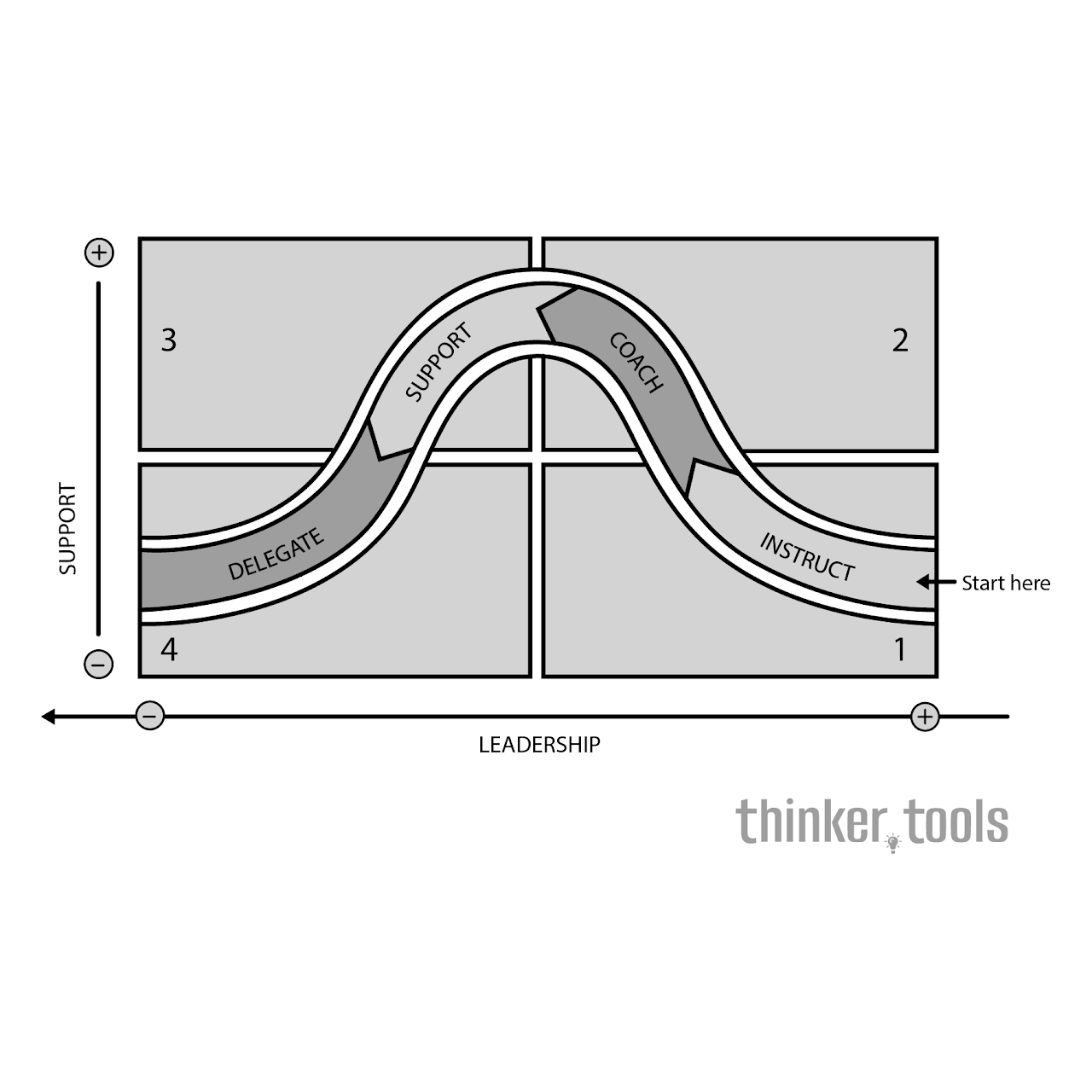
What is Situational Leadership?
Situational Leadership is an adaptive leadership framework that recognizes there's no single "best" leadership style. Instead, effective leadership requires flexibility – adjusting your approach based on the competence and commitment levels of the people you're leading and the specific task at hand.
The framework provides four leadership styles and shows when to use each one, based on followers' development levels. This creates a dynamic approach where leaders can support team members exactly where they are, neither overwhelming nor under-challenging them.
The History and Origin
Situational Leadership was developed by Paul Hersey and Ken Blanchard in the late 1960s while working on their book "Management of Organizational Behavior." Originally called the "Life Cycle Theory of Leadership," it evolved through decades of research and practice.
The model gained widespread adoption in corporate training programs because of its practical applicability. Blanchard later refined his version into "Situational Leadership II," while Hersey continued developing the original model. Both versions share core concepts while differing in specific terminology.
How to Use the Situational Leadership Framework
Understanding Development Levels
Team members vary in two dimensions:
- Competence: Skills, knowledge, and experience for the task
- Commitment: Motivation, confidence, and enthusiasm
This creates four development levels:
- D1 - Enthusiastic Beginner: Low competence, high commitment
- D2 - Disillusioned Learner: Some competence, low commitment
- D3 - Capable but Cautious: High competence, variable commitment
- D4 - Self-Reliant Achiever: High competence, high commitment
The Four Leadership Styles
S1 - Directing (for D1):
- High directive, low supportive behavior
- Clear instructions and close supervision
- Tell what, how, when, and where
- Best for enthusiastic beginners
S2 - Coaching (for D2):
- High directive, high supportive behavior
- Explain decisions and provide opportunity for clarification
- Still leader-driven but with more dialogue
- Best for those experiencing reduced motivation
S3 - Supporting (for D3):
- Low directive, high supportive behavior
- Share ideas and facilitate decision-making
- Focus on building confidence
- Best for competent but cautious performers
S4 - Delegating (for D4):
- Low directive, low supportive behavior
- Turn over responsibility for decisions
- Monitor progress without micromanaging
- Best for self-motivated experts
Step-by-Step Implementation
Step 1: Assess the Situation
Consider:
- What specific task or goal is involved?
- What's the complexity level?
- What are the stakes or consequences?
- What's the timeline?
Step 2: Diagnose Development Level
For each team member, evaluate:
- Their skill level for this specific task
- Their motivation and confidence
- Past performance on similar tasks
- Current energy and engagement
Step 3: Match Your Leadership Style
Select the appropriate style:
- D1 → S1 (Directing)
- D2 → S2 (Coaching)
- D3 → S3 (Supporting)
- D4 → S4 (Delegating)
Step 4: Apply the Style
Implement your chosen approach:
- Adjust your communication
- Modify your involvement level
- Change your decision-making process
- Adapt your feedback frequency
Step 5: Monitor and Adjust
Continuously assess:
- Is the person progressing?
- Has their development level changed?
- Do you need to shift styles?
- Are you achieving desired outcomes?
Practical Examples
New Employee Onboarding: Sarah joins the marketing team with enthusiasm but no experience in the company's systems. Her manager uses S1 (Directing), providing detailed instructions for each task, checking work frequently, and giving specific feedback until Sarah builds competence.
Mid-Project Slump: Tom, initially excited about leading a project, becomes discouraged when facing unexpected challenges. His manager shifts to S2 (Coaching), maintaining clear direction while also providing emotional support and explaining the reasoning behind decisions.
Experienced but Hesitant: Lisa has successfully completed similar projects but lacks confidence in a high-visibility assignment. Her manager uses S3 (Supporting), facilitating her decision-making and building confidence while letting her take the lead.
Veteran Team Member: Ahmed has deep expertise and high motivation for his work. His manager uses S4 (Delegating), setting goals together then stepping back, checking in periodically but avoiding micromanagement.
Benefits and Life Impact
Mastering Situational Leadership creates profound improvements in leadership effectiveness:
Accelerated Development: Team members progress faster when receiving leadership matched to their needs, neither overwhelmed nor under-stimulated.
Increased Engagement: People feel seen and supported appropriately, leading to higher motivation and job satisfaction.
Reduced Frustration: Both leaders and team members experience less frustration when expectations match capability levels.
Improved Performance: Teams perform better when leadership style matches their development needs for specific tasks.
Greater Flexibility: Leaders become more adaptable, able to work effectively with diverse team members and situations.
Better Relationships: Understanding that different people need different approaches reduces conflict and builds stronger connections.
Efficient Resource Use: Leaders invest time and energy appropriately, not over-managing experts or under-supporting beginners.
Cultural Sensitivity: The framework helps leaders adapt to cultural differences in authority expectations and communication styles.
Personal Application: These principles apply beyond formal leadership to parenting, teaching, coaching, and peer relationships.
Situational Leadership revolutionizes how we think about leadership by rejecting the idea that leaders should treat everyone the same. Instead, it honors the unique needs of each person at each point in their development journey. This framework transforms leadership from a static role into a dynamic dance, where leaders continuously adjust their approach to bring out the best in others. Whether you're leading a multinational corporation or helping a child learn to ride a bike, Situational Leadership provides the tools to match your support to their needs, creating conditions for optimal growth and performance. The result is not just better outcomes, but stronger, more trusting relationships built on understanding and appropriate support.